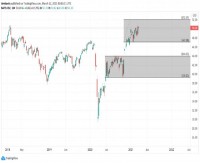|
Opalesque Industry Update - >> The Lyxor Hedge Fund Index was down -0.3% in December 2014 (YTD -0.2%). 3 out of 12 Lyxor Indices ended the month in positive territory, led by the Lyxor CTA Long Term Index (+3.5%), the Lyxor L/S Equity Variable Bias Index (+1.2%), the Lyxor Merger Arbitrage Index (+0.2%). >> Slower and disparate global recovery. The end of 2013 optimism was tempered in Q1. EU recovery failed to gain traction under deflationary pressures. The Japanese momentum was cut short by its consumption tax. The pulse in China peaked during the summer. EM growth continued to moderate overall, with substantial country divergences. The US stood out. After an unusually weak and confusing Q1, growth snapped back in most of its economic sector, to the notable exception of housing. >> Global inflation remaining stubbornly low. Unlike diverging GDP trends, the fall in inflation was worldwide. It was driven both by cyclical and structural forces, the mix of which differed across regions. >> The Fed passing the baton to peers. While ending its tapering, the Fed carefully blew hot and cold over the year to prepare for the first rate, with limited collateral damages. Non-US central banks' agenda was much busier. While still seen behind the curve, ECB provided lenders with a variety of instruments. BoJ’s main surprise came out in October. Its accommodative stance was reaffirmed along with a delayed second consumption rate hike and general elections. In addition to multiple micro stimulus since the summer, PBOC cut rates in November. >> The bond inflection mirage. Sovereign yields contracted and curve flattened globally - a surprise in the US especially. It resulted from tempered GDP growth, weaker inflation expectations and dovish central banks. >> US economic leadership expressed in dollars and equities. USD soared up in H2 against JPY, EUR, and most EM crosses. US equities outperformed most markets. Slight gains in Europe and Japan benefited from asset reflation though with growing doubts on policies success. Chinese equities remained anemic before surging in H2 on PBoC easing and the HK/Shanghai connect. >> Credit finally caught up by thickening market liquidity and the energy meltdown. US credit remained resilient until the summer wake-up call in the most vulnerable segments. Carry chase and market depth dried out, the selling accelerated with the energy meltdown. >> The unexpected crude oil collapse. Stronger Chinese pulse and geopolitical stresses kept oil prices steady in H1. A turn in both factors, worsening supply conditions and risk aversion then weighed on prices. A vicious cycle spiraled when OPEC made it clear that it was starting a market share war with a view to forcing its competitors clear the oversupply. Oil prices failed to stabilize, fuelling deflationary fears and pressure on credit and EM assets. >> Polarized December hedge funds returns. Credit funds strongly underperformed taking a full hit from the oil scare that sank the energy credit, and the HY space along with it. In contrast, CTAs thrived in a very directional environment, with continued USD trend and naturally hedged exposures to the equity downturn and the bonds' upside. The Event Driven resilience witnessed the portfolio rotations and hedges implemented since the growth scare. The L/S Equity funds also proved resilient enough, with high dispersion. Adverse beta contribution was supported by strong alpha generation, in Europe especially, and a rally in Asian exposures thanks to PBoC. >> Limited alpha and directionality in H1, with the last phase of volatility compression and carry chase. Growth global downgrades and the confusion from US climate, Ukraine and the Chinese shadow banking, squeezed market directionality. Volatility nearing all time lows and a severe lack of dispersion left alpha generators with scarce opportunities. They crowded in few market segments which violently unwound during the Spring rotation. A challenging backdrop to extract excess returns... Credit and Event Driven outperformed, other strategies didn't produce meaningful returns. >> Violent beta tectonic and the return of alpha in H2, with a succession of V-shocks and thin liquidity. Five violent market rotations unfolded in 2014 in contrast with just one in 2013 and in 2012: the 'Growth disappointment' pullback in January, the 'Spring rotation', the 'Summer flight to liquidity and quality', a major 'Growth scare' in September, the 'Oil scare' in December. Over the period, speculative catalysts prevailed (central banks and geopolitics especially): implementing fundamental approaches was made all the more complex. The liquidity premium repricing sharply hit Credit & Event Driven funds. Outperforming strategies exploited the volatility inflection and the return of alpha both at a macro and micro levels. These include L/S equity market neutral, relative-value macro funds, and above all CTAs: their agnosticism to macro anomalies gave them a leading edge. >> A frustrating year for active asset management. Most mutual funds underperformed their benchmark; hedge funds were around flat; closed-end, REITs and private equity funds also suffered. Heading into 2015, global economy is standing at a pivotal point. Abundant macro liquidity is colliding with disinflation uncertainties. Markets are likely to remain challenging in the near future. That said, the return of macro and micro dispersion has been long expected and is the good news for hedge funds heading into next year. >> “Current market conditions will likely stay bumpy. We favor liquid, diversified strategies most likely to benefit from reflation and from the return of alpha.”, says Jeanne Asseraf-Bitton, Global Head of Cross Asset Research at Lyxor AM.
From Lyxor’s The Alternative Investment Industry Barometer, January 2014 Bg |
Industry Updates
Lyxor Hedge Fund Index ‐0.27% (est.) in December, ‐0.17% for 2014
Thursday, January 15, 2015
|
|





 RSS
RSS







